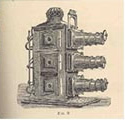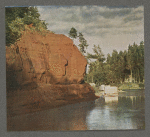Color Photography Method |
Introduction | Digital Color Composites | Digital Color Renderings | Other Color Representations
Introduction
 Lantern Projector from: Thomas Cradock Hepworth, Book of the Lantern. New York: Edward L. Wilson, 1889 |
Prokudin-Gorskii created his negatives by using a camera that exposed one oblong glass plate three times in rapid succession through three different color filters: blue, green, and red. For formal presentations, he printed positive glass slides of these negatives and projected them through a triple lens magic lantern. Prokudin-Gorskii would project the slide through the three lenses, and, with the use of color filters, superimpose the three exposures to form a full color image on a screen. (For more illustrations of Prokudin-Gorskii's methods, see the "Making Color Images" section of the exhibit, The Empire That Was Russia.)
|
|
Because of the active interest researchers have expressed in Prokudin-Gorskii's color work, the Library of Congress has contracted on two separate occasions to have color representations made. The resulting electronically created digital color representations are not offered as historic reconstructions of the exact colors that Prokudin-Gorskii was able to show his audiences. The basic colors could be determined from the filtered glass negatives, but it is also important to remember that color has many subjective qualities. For instance, the digital colors are richer and brighter than the color inks used in the prints Prokudin-Gorskii published in the Fotograf-liubitel' in 1906 [retrieve color prints from Fotograf-liubitel']. The color representations may differ when viewed on different monitors or printed on different printers.
Digital Color Composites
In 2004, the Library contracted with Blaise Agüera y Arcas to produce an automated color composite of each of the 1,902 negatives from the high resolution digital images of the glass plate negatives. The software algorithm he developed combines the three images into one, makes minute adjustments to align parts of the image that appear to have moved from exposure to exposure, and applies the appropriate color layer. Mr. Agüera y Arcas supplied a complete description of his process.
Some of the automated composites did not align properly due to extreme subject movement, broken sections of the glass negatives, or cases in which the plate shifted drastically in the camera. [Retrieve examples]
In making the composites, Mr. Agüera y Arcas registered the color to the middle frame of the glass negatives, leaving generous margins on the top and bottom in order to avoid eliminating any visual information. As a consequence, colored stripes can be seen at the top and bottom of all of the color composites.
Digital Color Renderings
In 2000, advances in electronic photo editing technology allowed the Library to commission 122 representative Prokudin-Gorskii images as full color renderings [view items with color renderings]. Walter Frankhauser of WalterStudio in Monrovia, Maryland, created the digital renderings from very high resolution digital images of the glass plate negatives. He separated the three images (top, middle, bottom) in the digitized file into three separate digital files and labeled blue, green, and red. He then sandwiched the three color files electronically one on top of the other, registering and adjusting for color contrast and color balance to present a single color rendering. (For further information about Frankhauser's color rendering process, see the "Making Color Images" section of the online exhibit, The Empire That Was Russia.)
Other Color Representations
Several other individuals and organizations have produced color composites using the digital image files from the Library of Congress Web site. The projects the Library of Congress is aware of are listed below.
 The
Library of Congress does not maintain
these Internet sites. Users should direct
concerns about these links to their respective
site administrators or webmasters.
The
Library of Congress does not maintain
these Internet sites. Users should direct
concerns about these links to their respective
site administrators or webmasters.
-
Dellaert, Frank. Prokudin-Gorskii Images, 2001
http://www-2.cs.cmu.edu/~dellaert/aligned/ -
Gridenko, Alex. Digichromatography: Restoring Prokudin-Gorskii's Photographs
http://www.gridenko.com/pg1/index2.htm -
Manning, Russell. Automatic Recombination of Separated Color Channels, 2001
http://www.cs.wisc.edu/~rmanning/homepage/research/prokudin-gorsky/ -
The Russian Record: The Work of Sergei Mikhailovich Prokudin-Gorskii (1863-1944) Precolor Plates Provided Freely by the Library of Congress Prints & Photographs Division
Composite Color Images Created by the Internet Community, 2001-
http://www.ummagurau.com/art/russia/ Šechtl and Vosecek Museum of Photography. Sergei Mikhailovich Prokudin-Gorsky: A Selection from the Collection ..., 2006.(Includes images of the kind of camera used by Prokudin-Gorskii and a history of color photography.)
http://sechtl-vosecek.ucw.cz/en/expozice5.html-
The World of 1900-1917 in Color: The Complete Collection of Prokudin-Gorsky is Registered in High Resolution Color
©2003 LabRT, Restavrator-M
http://www.prokudin-gorsky.ru/ -
Yaroslav' University in association with the "Internet-Socium" organization in Moscow; images also exhibited at the Russian Museum in St. Petersburg in April 2003 (text in Russian)
http://www.prok.uniyar.ac.ru -
Images Prokudin-Gorskii took in the town of Ostashkov (text in Russian)
http://www.ostashkov.ru/prokudin-2003/prokudin.asp -
Images from the Central Asian town of Chimkent (text in Russian)
http://chimkent.by.ru/Gorskii.html -
Essay on the significance of the Prokudin-Gorskii collection (text in Russian)
http://port-folio.org/part170.htm -
http://www.computerra.ru/offline/2001/419/13810 (text in Russian)
[START OVER] [ NEW SEARCH] [ "ABOUT" MENU] [ HELP]
 Library
of Congress
Library
of Congress( March 13, 2006 )

